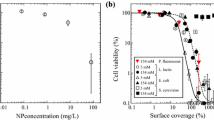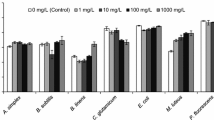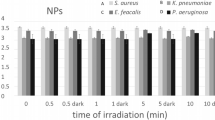Abstract
The cytotoxicity and colloidal behavior of surface-functionalized polystyrene latex (PSL) nanoparticles (NPs) (nominal diameter: 100 nm) toward a model gram positive bacterium Lactococcus lactis JCM 5805 were examined. Nearly all the L. lactis cells exposed to the negatively charged PSL NPs survived because the surface of the bacterial cell was charged negatively, and the NPs therefore hardly adhere to the cell surface. In contrast, the positively charged PSL NPs adhered to the L. lactis cell surface but were not entrapped within the cell, and cell death subsequently occurred. The bacterial growth curves after the toxic NP exposure suggested that NP toxicity did not affect the specific growth phase, but did affect lag time. These results indicated that the cells were damaged by the cell disruption that resulted from the adhesion of the NPs to the cell surface. Finally, the cytotoxicity of the toxic, positively charged PSL NPs toward L. lactis was compared with that displayed toward a model gram negative bacterium Escherichia coli and a model eukaryote Saccharomyces cerevisiae. The cytotoxic behaviors of NPs on L. lactis and E. coli were similar, and depended not on the bacterial surface structure, but rather the environmental ionic strength. In contrast, the cytotoxicity of the prokaryote bacteria was higher than that toward the model eukaryote S. cerevisiae. The difference between the NP sensitivities of the prokaryote and eukaryote resulted from the prokaryote’s lack of an endocytotic pathway.







Similar content being viewed by others
References
Arora S, Rajwade JM, Paknikar KM (2012) Nanotoxicology and in vitro studies: the need of the hour. Toxicol Appl Pharm 258:151–165
Bolla JM, Alibert-Franco S, Handzlik J, Chevalier J, Mahamoud A, Boyer G, Kieć-Kononowicz K, Pags JM (2011) Strategies for bypassing the membrane barrier in multidrug resistant Gram-negative bacteria. FEBS Lett 585:1682–1690
Calvayrac C, Romdhane S, Barthelmebs L, Rocaboy E, Cooper JF, Bertrand C (2014) Growth abilities and phenotype stability of a sulcotrione-degrading Pseudomonas sp. isolated from soil. Int Biodeterior Biodegrad 91:104–110
Chaudhry Q, Scotter M, Blackburn J, Ross B, Boxall A, Castle L, Aitken R, Watkins R (2008) Applications and implications of nanotechnologies for the food sector. Food Addit Contam 25:241–258
Doktycz MJ, Sullivan CJ, Hoyt PR, Pelletier DA, Wu S, Allison DP (2003) AFM imaging of bacteria in liquid media immobilized on gelatin coated mica surfaces. Ultramicroscopy 97:209–216
Ferrari M (2005) Cancer nanotechnology: opportunities and challenges. Nat Rev Cancer 5:161–171
Florence AT (2004) Issues in oral nanoparticle drug carrier uptake and targeting. J Drug Target 12:65–70
Guzman M, Dille J, Godet S (2012) Synthesis and antibacterial activity of silver nanoparticles against gram-positive and gram-negative bacteria. Nanomedicine 8:37–45
Hajipou MJ, Fromm KM, Akbar Ashkarran A, Jimenez de Aberasturi D, Larramendi IRD, Rojo T, Serpooshan V, Parak WJ, Mahmoudi M (2012) Antibacterial properties of nanoparticles. Trends Biotechnol 30:499–511
Kahru A, Dubourguier HC (2010) From ecotoxicology to nanoecotoxicology. Toxicology 269:105–119
Kahru A, Ivask A (2013) Mapping the dawn of nanoecotoxicological research. Acc Chem Res 46:823–833
Liu Y, Li W, Lao F, Liu Y, Wang L, Bai R, Zhao Y, Chen C (2011) Intracellular dynamics of cationic and anionic polystyrene nanoparticles without direct interaction with mitotic spindle and chromosomes. Biomaterials 32:8291–8303
Lunov O, Syrovets T, Loos C, Beil J, Delacher M, Tron K, Nienhaus GU, Musyanovych A, Mailänder V, Landfester K, Simmet T (2011) Differential uptake of functionalized polystyrene nanoparticles by human macrophages and a monocytic cell line. ACS Nano 5:1657–1669
Mahler GJ, Esch MB, Tako E, Southard TL, Archer SD, Glahn RP, Shuler ML (2012) Oral exposure to polystyrene nanoparticles affects iron absorption. Nat Nanotechnol 7:264–271
Miyazaki J, Kuriyama Y, Miyamoto A, Tokumoto H, Konishi Y, Nomura T (2013) Bacterial toxicity of functionalized polystyrene latex nanoparticles toward Escherichia coli. Adv Mater Res 699:672–677
Miyazaki J, Kuriyama Y, Miyamoto A, Tokumoto H, Konishi Y, Nomura T (2014) Adhesion and internalization of functionalized polystyrene latex nanoparticles toward the yeast Saccharomyces cerevisiae. Adv Powder Technol 25:1394–1397
Miyazaki J, Kuriyama Y, Tokumoto H, Konishi Y, Nomura T (2015) Cytotoxicity and behavior of polystyrene latex nanoparticles to budding yeast. Colloid Surf A 469:287–297
Musee N, Thwala M, Nota N (2011) The antibacterial effects of engineered nanomaterials: implications for wastewater treatment plants. J Environ Monit 13:1164–1183
Nel A, Xia T, Mädler L, Li N (2006) Toxic potential of materials at the nanolevel. Science 311:622–627
Nomura T, Narahara H, Tokumoto H, Konishi Y (2009) The role of microbial surface properties and extracellular polymer in Lactococcus Lactis aggregation. Adv Powder Technol 20:537–541
Nomura T, Miyazaki J, Miyamoto A, Kuriyama Y, Tokumoto H, Konishi Y (2013) Exposure of the yeast Saccharomyces cerevisiae to functionalized polystyrene latex nanoparticles: influence of Surface charge on toxicity. Environ Sci Technol 47:3417–3423
Ohshima H (1995) Electrophoresis of soft particles. Adv Colloid Interface Sci 62:189–235
Ohshima H, Makino K, Kato T, Fujimoto K, Kondo T, Kawaguchi H (1993) Electrophoretic mobility of latex particles covered with temperature-sensitive hydrogel layers. J Colloid Interface Sci 159:512–514
Sagalowicz L, Leser ME (2010) Delivery systems for liquid food products. Curr Opin Colloid Interface Sci 15:61–72
Singh R, Lillard JW Jr (2009) Nanoparticle-based targeted drug delivery. Exp Mol Pathol 86:215–223
Sonohara R, Muramatsu N, Ohshima H, Kondo T (1995) Differences in surface properties between Escherichia coli and Staphylococcus aureus as revealed by electrophoretic mobility measurements. Biophys Chem 55:273–277
Sozer N, Kokini JL (2009) Nanotechnology and its applications in the food sector. Trends Biotechnol 27:82–89
Takashima S, Morisaki H (1997) Surface characteristics of the microbial cell of Pseudomonas syringae and its relevance to cell attachment. Colloid Surf B 9:205–212
van Loosdrecht MC, Lyklema J, Norde W, Schraa G, Zehnder AJ (1987) Electrophoretic mobility and hydrophobicity as a measured to predict the initial steps of bacterial adhesion. Appl Environ Microbiol 53:1898–1901
Vasir JK, Reddy MK, Labhasetwar VD (2005) Nanosystems in drug targeting: opportunities and challenges. Curr Nanosci 1:47–64
Yoshihara Y, Narahara H, Kuriyama Y, Toyoda S, Tokumoto H, Yasuhiro K, Nomura T (2014) Measurement of microbial adhesive forces with a parallel plate flow chamber. J Colloid Interface Sci 432:77–85
Zwietering MH, Jongenburger I, Rombouts FM, Van’t Riet K (1990) Modeling of the bacterial growth curve. Appl Environ Microbiol 56:1875–1881
Acknowledgments
This work was supported by the Japan Society for the Promotion of Science, KAKENHI Grant Number 24310066. The authors thank Ms. K. Okuno and Ms. M. Nishiura for their help with the laboratory work.
Author information
Authors and Affiliations
Corresponding author
Electronic supplementary material
Below is the link to the electronic supplementary material.
Rights and permissions
About this article
Cite this article
Nomura, T., Kuriyama, Y., Tokumoto, H. et al. Cytotoxicity of functionalized polystyrene latex nanoparticles toward lactic acid bacteria, and comparison with model microbes. J Nanopart Res 17, 105 (2015). https://doi.org/10.1007/s11051-015-2922-8
Received:
Accepted:
Published:
DOI: https://doi.org/10.1007/s11051-015-2922-8




